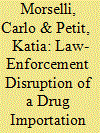|
|
|
Sort Order |
|
|
|
Items / Page
|
|
|
|
|
|
|
| Srl | Item |
| 1 |
ID:
119503


|
|
|
|
|
| Publication |
2013.
|
| Summary/Abstract |
There have been growing claims in media circles and law-enforcement settings that street gangs and criminal groups are turning to Internet-based social networking sites for various reasons ranging from the showcasing of their images and exploits to the suspected recruitment of members. The present study investigates whether such a trend is, in fact, in place. The presence of street gangs on these Internet sites is referred to as cyberbanging. While there is some anecdotal evidence suggesting that gangs are turning to social networking sites, there is little available research on exactly how street gangs and criminal groups use the Internet. Our main argument is that gang culture is in many ways an individualized phenomenon and this feature ties in directly with recent assessments of the Internet as a setting that is governed by a process of networked individualism. This theoretical link between the individualized gang setting and the presence of gang members on social networking sites helps us understand why recruitment is improbable even in a context where people are openly diffusing their image and exploits to a growing number of Internet users. The empirical segment of this research adds to this general outlook. Based on a keyword search of over 50 street gang names, the three main social networking sites (Twitter, Facebook, and MySpace) were monitored for street gang presence. Results illustrate that gang presence on social networking sites is linked primarily to promoting a general gang or street culture through individual displays. In regard to the visitors to such sites, there is no evidence that they are being tricked or manipulated in any way. They are, however, showing their curiosity in regard to such groups and, for those who share their comments and opinions, signs of support are evident. Thus, whereas criminal gangs are not proactively using the Internet to convert anyone into being gang members, social networking sites are creating a new venue for people who share or are sensitive to the values underlying street gang lifestyle to come together. These sites essentially create a new convergence setting for gang members to interact with a wider number of people who would probably never have been exposed to their lifestyles and exploits through physical interactions. The study's conclusion extends these findings toward further research in this area, as well as outlining the more relevant implications for law-enforcement monitoring of this growing phenomenon.
|
|
|
|
|
|
|
|
|
|
|
|
|
|
|
|
| 2 |
ID:
078970


|
|
|
|
|
| Publication |
2007.
|
| Summary/Abstract |
This study focuses on the structure and evolution of a drug importation network that operated from Montreal, Canada, and that was the target of an extensive 2-year criminal investigation. The investigation was atypical in that it followed a seize-but-do-not-arrest strategy - while 11 drug shipments were seized by police throughout this period, arrests were never made until the final phase of the investigation. Such a case offers a rare opportunity to study the dynamics of a criminal network under intense surveillance and disruption. The reconstruction of the importation network is based on electronic communication transcripts that were intercepted and compiled during the investigation. Findings from analyses of the principal changes that took place within the communication network reveal how network centralization and critical node status are variable, and not static, properties of a criminal network under considerable constraint. The study demonstrates how a criminal network decentralizes and is re-ordered in response to intense law-enforcement targeting. Contributions are made to research on disruption in criminal networks. We conclude with a discussion on how a criminal network's flexibility, a feature generally presented as a sign of resilience, may contribute to a more significant demise within a context of intensive control
|
|
|
|
|
|
|
|
|
|
|
|
|
|
|
|
| 3 |
ID:
106141


|
|
|
|
|
| Publication |
2011.
|
| Summary/Abstract |
This article reviews evidence from past research that addresses diverse themes and theories regarding shifts and patterns in the mobility of criminal groups. Our main objective is to identify push and pull factors that will help us understand how and why criminal groups, organisations or general organised crime patterns are present across a variety of settings (i.e. geographical locations, criminal markets and legitimate industries). Push factors refer to forces which drive criminal groups from a setting. Pull factors refer to forces which draw criminal groups to a setting. A distinction is also made between contexts in which offenders organise around available opportunities (the strategic context) and contexts in which opportunities induce greater organisational levels amongst offenders (the emergent context). The most general statement that can be formulated from the present exercise is that opportunities matter more than the group itself. What we demonstrate is that the problems concerning geographical locations, criminal markets and legitimate industries that are vulnerable to organised crime are persistent and stable over time. Groups that seize such opportunities, on the other hand, are transient and more than often short-lived. Aside from reviewing past research in search of such factors, we also apply the general understanding that emerges from our analysis to critically assess case studies that reflect popular images of organised crime threats in Canada during recent years. The concluding section identifies the key issues that must be addressed within this area.
|
|
|
|
|
|
|
|
|
|
|
|
|
|
|
|
|
|
|
|
|